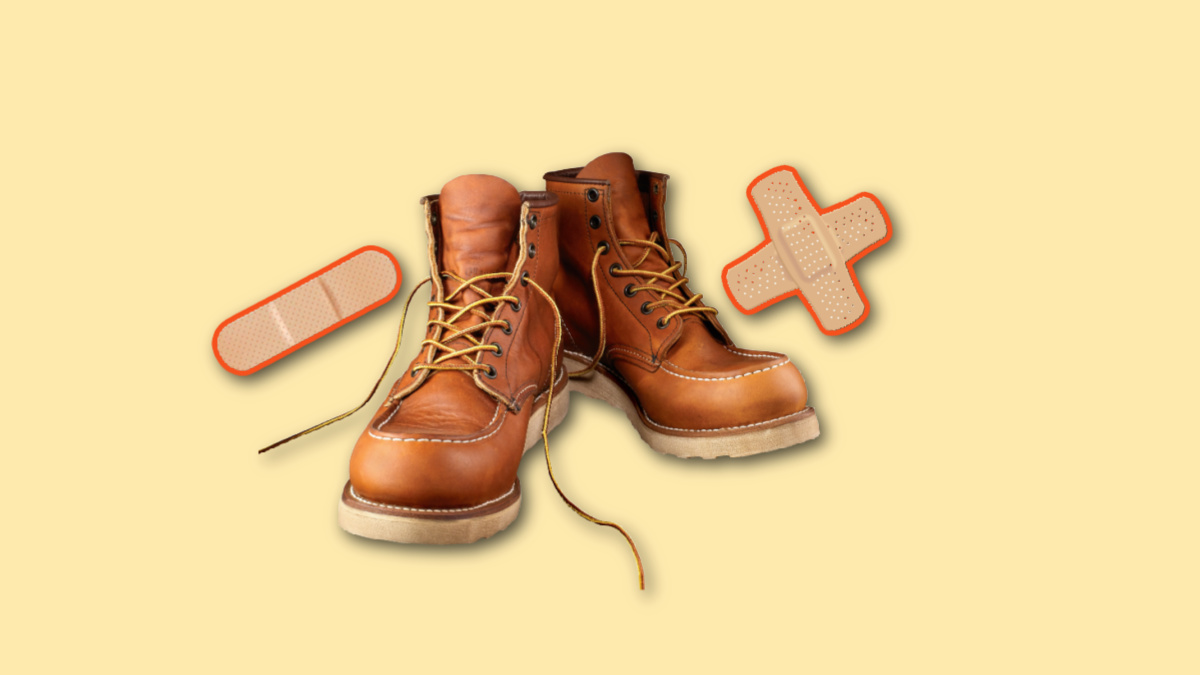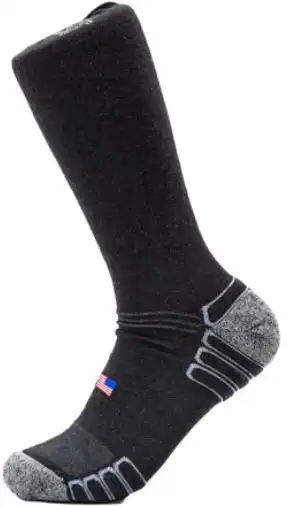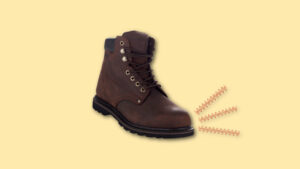- Get a good pair of wool socks
- Get tongue pads
- Use a shoe stretcher
- Elevate your feet on breaks
- Don’t wear new boots all day
- Install work boot insoles
- Sprinkle on cornstarch
- Double up your socks
Feeling that stinging pain in the back of your heel when you’ve still got four more hours left in your shift is no fun.
Every foreman has a few “old-man” tricks for how to avoid blisters from your boots, but some are downright outrageous.
As someone who’s suffered through a few blisters of my own, I’ve figured out a few easy hacks to prevent blisters on my feet (plus a few ways to quickly heal blisters if they do form).
Use these hacks now and you’ll never have another blister again.
Table of Contents
9 Ways to Stop Getting Blisters from Your Boots
1. Get a Good Pair of Wool Socks
Cotton socks absorb moisture and can lead to blisters.
Instead, opt for wool socks that wick away moisture. Wool allows better air circulation so that your feet don’t sweat as much when they’re trapped in a sweaty boot all day long.
Wool work socks from Camel City Mill are thermoregulated so your feet sweat (and stink) less, and cause less friction between your boot and skin, which helps prevent blisters.
Made with Ironside Merino wool, these work socks feature compression through the calf which promotes better bloodflow and helps your feet recover after a long day. Plus, because they're Merino wool, they're breathable and completely knock out foot-sweat.
2. Get Tongue Pads
Tongue pads create a thicker tongue if your boots are too big and slip a little.
They help keep your feet firmly in place where they should be. Many times, tongue pads are thought to be used more in dress shoes, but there’s no reason not to use them in work boots too.
3. Use a Shoe Stretcher
Break in your boots with a shoe stretcher.
This will help stretch out the leather and make them more comfortable to wear. If your boots are too tight of a fit, a shoe stretcher helps bring them up to the right size without you having to buy a brand new pair.
4. Elevate Your Feet on Breaks
If you’re working on your feet, take regular breaks and elevate your feet to give them a rest. This can help reduce swelling and prevent blisters from forming.
5. Don’t Wear New Boots All Day
Don’t wear a new pair of work boots for the first time all day.
Take them out for a walk around the block first, then try them on at home with some socks. This way you’ll know if they fit correctly and won’t give you blisters.
And when you do get a new pair of boots, bring your old beaters with you to the job site. A lot of guys I know will break in their new boots until lunch and then swap out for their old comfortable boots for the rest of the day so their puppies aren’t barking too loud.
6. Install Work Boot Insoles
Buy a pair of insoles that are made specifically for work boots. These will help keep your feet from slipping and sliding inside your boots, plus they’ll add extra arch support, which can definitely help if you struggle with knee or lower back pain.
7. Sprinkle on Cornstarch
Sweat causes friction. Which causes blisters.
When your feet start sweating, they can rub against the inside of your boot, which irritates the skin and can raise a blister. Cornstarch will reduce that friction (baby powder works too).
So if you start to feel too much rubbing in your feet, bust out the dust.
8. Double Up Your Socks
Wear double-layer socks—they’ll protect your feet from friction between layers while still absorbing moisture from sweating (if you wear socks made from synthetic or wool, not cotton).
9. Double-check Your Boot Size
Make sure your feet fit well in your boots. You should have about 1/4 inch of space between your longest toe and the end of the boot. Don’t just choose a boot size because you’ve always worn that size. If you think you’re a size 11 but are still getting blisters, you may be choosing the wrong size boot.
To make sure you’re getting the right size, go to the closest shoe store near you and use a Brannock device. It’s that metal contraption that always scared you as a kid. And write that number down, too.
It not only gives you the right length of your foot, but it’ll also give you the width. You may be wearing D-width boots, when you really need EE or wider.
What to do If You Have Blisters From Your Work Boots Now
Blisters are a common occurrence, but they can be painful and annoying. Luckily, there are plenty of ways to treat and prevent blisters, so you don’t have to suffer through them any longer.
Here are five steps to help your blisters heal fast.
Step 1: Clean Your Skin
Clean the area around the blister with soap and water. This removes dead skin cells and bacteria that might be causing infection. This also helps prevent more infection from settling in while you’re waiting for the blister to heal on its own.
Step 2: Use an Antiseptic Cream
Apply an antibiotic cream or gel to protect against further infection while the blister heals itself from within (which typically takes about 3-4 days). This will also help keep dirt out of the blister and help it heal faster. It’s also important not to pop the blister yourself, which can lead to infection and scarring.
Step 3: Cover the Blister with a Band-Aid
Cover the blister with an adhesive bandage or gauze pad (don’t use tape). Make sure it’s completely covered so there’s a smaller chance of bacteria getting inside the blister while it heals.
Step 4: Change Your Boots If Necessary
As much as possible, change into shoes that don’t rub against your blister. Or even take your shoes completely off. For example, as soon as you get off work and get into your vehicle, take your boots and socks off. This will help airflow reach your feet and ensure nothing can rub against your blister and make it worse.
What Causes Blisters?
Blisters are often caused by friction between your skin and whatever you’re wearing on top of it. If your shoes are too tight or your sock is too thick, that can cause blisters to form right between your toes.
And if you’re not wearing the right type of shoe for the activity you’re doing—say, if you wear flip-flops when walking in the snow (which hopefully nobody is doing!)—you could get blisters on your heels from the snow melting into them.
On the other hand, heat can also cause blisters. So when you’re out in the sun for a long time and your feet start to get too hot, the constant heat hitting your foot can cause blisters to form.
Your body’s natural oils can also build up on your feet and cause friction when they rub against each other as you walk. This is why it’s so important to wash your feet before putting on socks or shoes.
If you have a cut or scrape on your foot (or anywhere else), and then it gets wet, you might end up with a blister on top of the cut. This is because the moisture makes the skin extra soft so it can’t protect itself from friction as well anymore.
And sometimes, even if everything feels fine at first, a blister can form later in the day because of a change in temperature. For example, if you go from working outside in the cold to walking around in a warm warehouse.
3 Hacks to Fix Boots that Give You Blisters
If you’ve tried everything you can think of and your boots are still giving you blisters, it may be time to break out the more extreme solutions. Some of these solutions (like soaking your boots in water) can damage leather, so don’t try these unless all else has failed.
1. Soak Your Boots in Water
Soak your boots in warm water for about 15 minutes. This will help break down the leather and make it more pliable—which means less friction on your feet.
2. Spray Your Boots with a Leather Stretch Solution
To help minimize damage to the leather, use a leather stretch spray. This is safer for leather than straight water.
Saturate the inside of your boots with the solution. Wear them around the house for an hour or two to help stretch the leather out and keep it from shrinking back down.
3. Rub in Soap
Once your boot is wet and pliable, lightly rub the inside of the boot with a bar of soap. Do this until it feels smooth and soft again (this may take some elbow grease).
Wipe off any excess soap with another piece of cloth or paper towel until they feel dry again.
Put your boots back on and walk to see if they’re more comfortable now. Walk around for an hour or two to help the leather stay stretched out to the size it needs to be so it doesn’t rub your feet.
Save Your Soles
Your heels will thank you if you follow these hacks to help prevent blisters from forming. From getting a good pair of wool socks to sprinkling cornstarch on your feet, there are a few tried-and-true tricks you can use to keep your feet blister-free.
FAQs
Is it normal to get blisters from new boots?
It’s normal to get blisters from new boots. Unlike soft sneakers, boots are created from harder materials that more easily cause friction on your feet, which forms blisters. The rougher materials, like leather, first need to be softened and broken in so they don’t cause blisters.
How long do boots take to break in?
Boots take 3-4 days to break in. However, don’t wear your new boots 24/7 until they’re broken in—that’s a good way to get blisters. Walk around the block a couple times and wear them in the house for a couple hours every day. Do this for about a week to break your boots in.
Do tight boots cause blisters?
Too-tight boots can cause blisters. So can boots that fit too loosely. This is because either way, too much friction is happening between your feet and boots. A too-tight boots rubs strongly against your skin (even through your sock), while too-loose boots let your feet slip around.



Join the Discussion